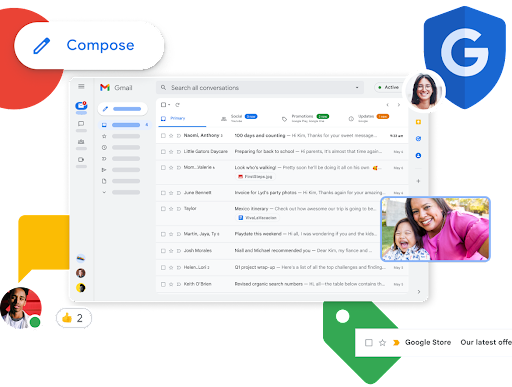Follow These Email Sender Guidelines For Gmail Personal Accounts

For Security And Communication
Google’s Gmail, one of the world’s most widely used email platforms, has rolled out stringent guidelines for email senders targeting personal Gmail accounts to enhance email security and streamline communication.
As of 2024, Gmail has over 1.8 billion active users worldwide, and 121 billion emails are sent through Gmail every day. In addition, over 602,874 business enterprises began using Gmail as an email management tool in 2023.
Effective from the dawn of 2024, senders must comply with the set regulations to ensure their emails reach Gmail users seamlessly. A personal Gmail account, denoted by an email address ending with ‘@gmail.com’ or ‘@googlemail.com,’ is the primary recipient for this set of guidelines.
Failure to adhere to these standards may result in restricted sending capabilities, blocked messages, or being tagged as spam by Gmail’s automated filters.
The guidelines address authentication, infrastructure configuration, subscription management, message formatting, and sending practices.
The following are the core aspects of these guidelines:
Authentication Requirements
Email senders must implement robust authentication protocols to establish sender authenticity and mitigate the risk of malicious activities such as spoofing and phishing.
These protocols, namely SPF (Sender Policy Framework), DKIM (DomainKeys Identified Mail), and DMARC (Domain-based Message Authentication, Reporting, and Conformance), are essential for safeguarding both senders and recipients. While SPF and DKIM are mandatory for all senders, bulk senders must also adopt DMARC.
Infrastructure Configuration Requirements
As specified in the Pointer (PTR) record, ensuring the alignment between the sending IP address and its associated hostname is pivotal. Moreover, shared IP addresses demand meticulous attention to prevent reputational damage due to co-users actions.

Subscription Management
Respecting user preferences and subscription choices is fundamental. Senders are advised to obtain explicit recipient consent, confirm email addresses before subscription, and facilitate hassle-free unsubscribing processes.
Message Formatting Standards
Email messages must adhere to HTML standards, incorporate valid message IDs, and refrain from deceptive practices such as hiding content or misleading headers. The use of standard characters in message elements and transparent representation of sender identity are emphasised.
Sending Practices
Maintaining consistency in sending practices, avoiding mixed message content, and refraining from impersonation or spamming tactics are vital for sustaining the sender’s reputation and ensuring deliverability.
Monitoring
It is recommended that domain reputation, spam, and open rates be regularly monitored—tools such as Postmaster Tools aid in diagnosing delivery issues and rectifying them promptly.
These guidelines represent a concerted effort by Gmail to fortify email communication against evolving threats while fostering a conducive environment for legitimate correspondence.
By adhering to these standards, email senders can enhance the reliability of their messages and contribute to the overall integrity of the email ecosystem.
Since 2004
Since its launch in 2004, Gmail – available in 105 languages – has transformed how individuals and businesses manage email correspondence. With its user-friendly interface, robust security features, and seamless integration with other Google services, Gmail has become the go-to choice for millions worldwide.
This massive user base reflects Gmail’s widespread adoption and trust as a leading email service provider, solidifying its position as one of the most popular communication platforms globally.
One of Gmail’s most notable features is its generous storage capacity, offering users ample space to store their emails, attachments, and files in the cloud. This has liberated users from the constraints of traditional email storage limits, allowing them to access their information from anywhere, at any time.
Furthermore, Gmail’s powerful spam filtering algorithms ensure that users receive only relevant emails, sparing them from the nuisance of sorting through unwanted messages. Its advanced security measures, including two-factor authentication and encryption, provide users with peace of mind, knowing their sensitive information is safeguarded against cyber threats.
Moreover, Gmail’s intuitive organisation tools, such as labels, filters, and priority inbox, enable users to manage their emails efficiently, enhancing productivity and reducing clutter.
In an era dominated by digital communication, Gmail continues to evolve, introducing new features and updates to meet its users’ ever-changing needs. Its enduring popularity and widespread adoption underscore its status as a cornerstone of modern email communication.
Featured image: As of 2024, Gmail boasts more than 1.8 billion active users worldwide. Credit: Yogas Design













